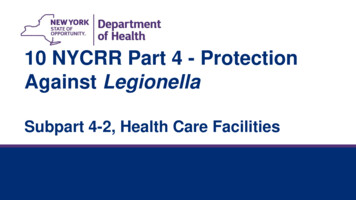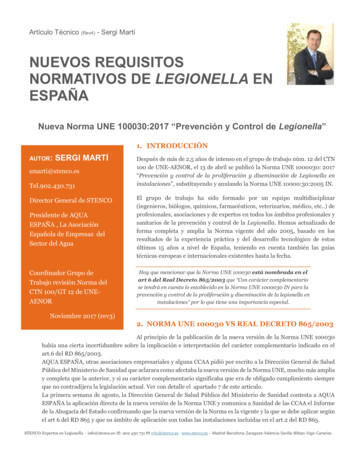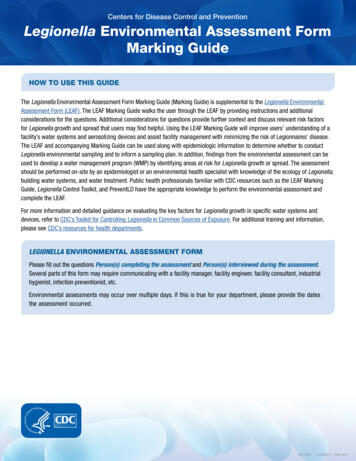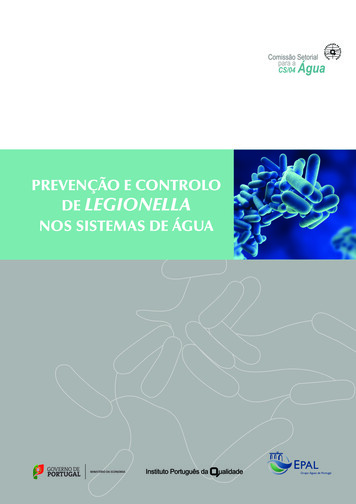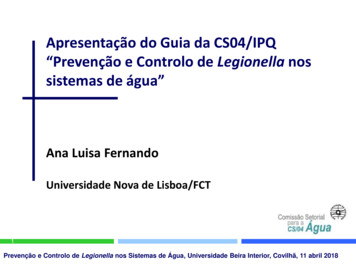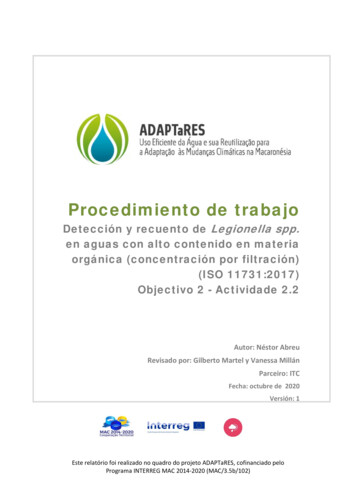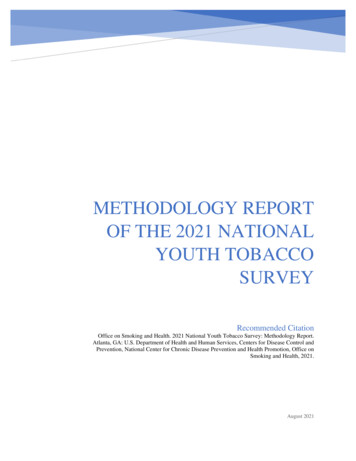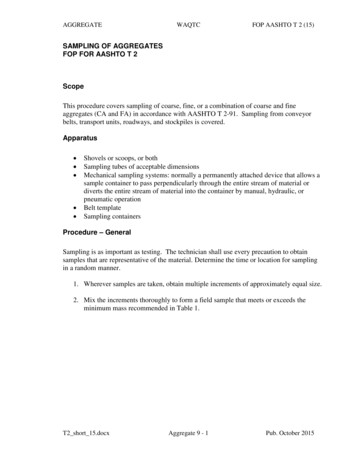
Transcription
Centers for Disease Control and PreventionSampling Procedure andPotential Sampling SitesProtocol for collecting environmental samples for Legionella cultureduring a cluster or outbreak investigation or when cases of diseasemay be associated with a facility.Sampling should only be performed after a thorough environmental assessment has been done and a samplingplan has been made. This protocol describes how to take standard biofilm swab, bulk water, and filter samples fromcommonly sampled sites. This protocol may be used in conjunction with the following tools:LEGIONELLA ENVIRONMENTAL ASSESSMENT FORMSAMPLE DATA SHEETLEGIONELLOSIS OUTBREAK INVESTIGATION VIDEOS:Legionella Ecology and an Introduction to Environmental Health and EngineeringConducting and Interpreting the Environmental AssessmentHow to Make a Sampling PlanHow to Sample Potable WaterHow to Sample Cooling TowersHow to Sample Spas and Fountains
MATERIALS NEEDED Sterile plastic 1 L bottles. (Glass bottles are not recommended due to risk of breakage during transport.)Sterile plastic 15 mL screw top tubes (with a tube rack) for biofilm swabs.Disposable Dacron/polypropylene-tipped swabs with wooden or plastic stems. Do NOT use cotton-tipped swabs asthey inhibit Legionella growth.Labels.0.1N solution of sodium thiosulfate (Na2S2O3) (15.81 g/L in distilled water, filter sterilize, replace every 12 months).Pipettes and bulbs for adding 0.5 mL of 0.1N sodium thiosulfate solution into 1 L water samples.Sterile plastic 500 mL or 1 L bottle for testing chlorine level, pH, and temperature.pH test kit.Chlorine test kit sensitive enough to detect chlorine level below 2 ppm and up to 10 ppm (may need two kits).Free chlorine may be measured when it is known that chlorine is the method of disinfection (as opposed tomonochloramine, bromine, or another disinfectant). Otherwise, measure total chlorine.Thermometer.Sample data sheet and pens.Large cooler, preferably with wheels. A 70 quart (66.2 L) horizontal cooler (a standard large picnic cooler) should fittwenty-five 1 L bottles, twenty-five 15 mL plastic tubes for biofilm swabs, thermometer, pH, and chlorine test kits. Forsampling of a larger facility (60–100 samples total), a second cooler that holds nothing but bottles, swabs, and tubesmay be needed. The cooler may be packed ahead of time and stored at ambient temperature for an unlimited time aslong as the sodium thoisulfate solution is replaced every 12 months.OPTIONAL MATERIALS Packing tape and scissors for sealing the cooler for mailing or air travel.Biohazard waste bags are useful for collecting trash.SAFETY PRECAUTIONSThe facility should be notified in advance to turn off (but do not drain or disinfect) anyaerosol-generating devices to minimize the risk to the sampling team. Persons atan increased risk of developing Legionnaires’ disease if exposed to Legionella (e.g.,immunocompromised individuals) should not accompany the sampling team.Optional personal protective equipment (PPE): Gloves are useful for sampling whirlpool spa filters or other sites that may be heavilycontaminated with organic material.Wearing a half-face air-purifying respirator equipped with an N95 filter may be appropriate inthe following situations: a.) when sampling cooling towers if the fans cannot be turned off, orb.) in enclosed spaces with an aerosol-generating device that cannot be turned off. Respiratorsmust be used in accordance with a comprehensive respiratory protection program, whichincludes fit testing, training, and medical clearance ahead of their use (see OSHA standard29 CFR 1910.134). For more information about N95 respirators, visit the National Institute forOccupational Safety and Health (NIOSH) website.2 CDC Sampling Procedure and Potential Sampling Sites www.cdc.gov/legionella/outbreak-toolkit/
SAMPLING POTABLE WATER AT THE POINTS OF USENote: In most situations, it’s appropriate to sample only the hot water. However, there are situations where taking some coldwater samples is helpful. For example, in hot climates, the cold water may be warm enough for rapid Legionella amplification( 77 F). Desalination may also elevate cold water temperature. Cold water could also be warm due to lack of insulationbetween hot and cold water pipes.Collect one biofilm swab and one bulk water sample from each sampling site (i.e., each showerhead or faucet).1. For showers, ask facility maintenance personnel to remove the showerhead. For faucets, ask them to remove the aerator.Take biofilm swabs:2. Turn on the water for a couple of seconds to moisten the pipe, and then turn it off. Insert a sterile Dacron- orpolypropylene-tipped swab deep into the faucet/pipe. Try to get beyond the bend and swab around the inside surfacefirmly without breaking the swab stem. (If there is visible biofilm on the inside of the showerhead or faucet aerator whenthese are removed, they can also be swabbed.)3. Place the swab into a 15 mL sterile plastic tube and add 3–5 mL of water from the same faucet to keep the swab tipmoist during transport. Snap the wooden or plastic swab stem approximately 1 in. from the top of the tube. Add a drop of0.1N sodium thiosulfate solution to neutralize residual disinfectants. Tighten the tube top to prevent leakage.4. Label the tube with a unique identifier. Record the type and location of the sample on a Sample Data Sheet, and place thetube into a cooler.Take bulk water samples:5. After the biofilm swab is collected, turn on the water and let it run until the water is warm but not hot. The goal is toobtain water currently in the piping behind the fixture along with any material shed from biofilm. Avoid heating waterexcessively (approximately 122 F or higher) since free-floating Legionella will die quickly at elevated temperatures.Collect 1 L of water from the faucet into a sterile 1 L bottle, leaving a 1 in. space at the top.6. Add 0.5 mL of 0.1N sodium thiosulfate solution to the water sample to neutralize residual disinfectants. Tighten the bottletop to prevent leakage.7. Label the bottle with a unique identifier. Record the type and location of the sample on the Sample Data Sheet, and placeit into the cooler.Measure water parameters:8. Run the hot water until it is as hot as it will get. Collect 100–300 mL of water in a separate plastic sampling bottle. Thesame bottle can be used for measuring water parameters at every sampling site. Measure temperature, pH, and chlorinelevel of the sample. Record all measured data on the Sample Data Sheet. If it takes more than a minute for the water toget hot it could indicate a local problem, such as with a mixing valve, or a system-wide imbalance.SAMPLING POTABLE WATER AT THE HOT WATER HEATERS1. Collect a bulk water sample only; it is rare that a biofilm sample can be obtained from a hot water heater since this wouldrequire completely draining the tank.2. Ask facility maintenance personnel to open the drain valve of the hot water heater and collect 1 L of water into a sterile1 L bottle, leaving a 1 in. space at the top.3. Add 0.5 mL of 0.1N sodium thiosulfate solution to the water sample to neutralize residual disinfectants. Tighten the bottletop to prevent leakage.4. Label the bottle with a unique identifier. Record the type and location of the sample on the Sample Data Sheet, andplace it into the cooler.5. Always measure and record the temperature, pH, and chlorine level of a bulk water sample collected from a hotwater heater.3 CDC Sampling Procedure and Potential Sampling Sites www.cdc.gov/legionella/outbreak-toolkit/
SAMPLING WHIRLPOOL SPAS1. Take biofilm swabs from inside several jets and at the water line.2. Place each swab into a 15 mL sterile plastic tube (one swab per tube) and add 3–5 mL of water from the whirlpool spatub to keep the swab tip moist during transport. Snap the wooden or plastic swab stem approximately 1 in. from the topof the tube. Add a drop of 0.1N sodium thiosulfate solution to neutralize residual disinfectants. Tighten the tube top toprevent leakage.3. Label each tube with a unique identifier. Rec
1L bulk water: Concentrate: Every well and water tower that supplies water to the ; facility/campus/building 1 per well or water : tower: 1L bulk water
